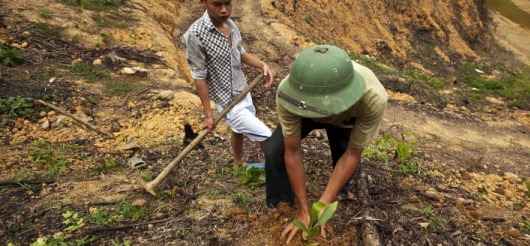Forest landscape restoration technical planning in Rwanda
10 December 2019
10 December 2019
In 2011, the Government of Rwanda pledged to bring 2 million hectares of deforested and degraded land into restoration by 2020. Compared to Rwanda’s total geographic area, This goal represents the highest proportion committed to the Bonn Challenge to date. Rwanda lost over 65% of its forests between 1956 and...
Uganda has made a significant pledge to the Bonn Challenge, committing to bring 2.5 million hectares of degraded and deforested land into restoration by 2020.
IUCN is supporting farmer-managed natural regeneration (FMNR) to implementing forest landscape restoration (FLR) in three districts in the Aswa catchment area in Northern Uganda –...
The social, environmental and economic benefits of Farmer Managed Natural Regeneration (FMNR)
19 April 2016
19 April 2016
This study reviews the key literature related to Farmer Managed Natural Regeneration (FMNR) in order to establish its benefits and limitations as well as identify any gaps in evidence. The study then outlines potential challenges in
meeting the identified gaps and recommends next steps to guide further evaluation and measurement.
FMNR...
Improving ecosystem functionality and livelihoods - Experiences in forest landscape restoration and management.
19 April 2016
19 April 2016
This paper examines how interventions intended to improve functionality and productivity of forested landscapes to improve livelihoods of the poorest populations, might actually yield co-benefits in terms of biodiversity conservation. It argues in favour of a ‘landscape’ approach to achieve these co-benefits.
Using case study examples from eight landscapes involved in...
In 2000, WWF collaborated with IUCN (and other conservation and development groups) in defining forest landscape restoration as: “a planned process that aims to regain ecological integrity and enhance human wellbeing in deforested or degraded landscapes”. The concept of forest restoration at a landscape scale emerged in part from recognition...
Increased investment in landscape restoration is essential for meeting ambitious global targets that already exist, including the Bonn Challenge to bring 150 million ha into restoration by 2020. Climate and development finance will not be sufficient to meet this level of ambition. Private finance has a very important role to...
Sustainable financing for forest and landscape restoration - Opportunities, challenges and the way forward
19 April 2016
19 April 2016
FAO and the Global Mechanism of the UNCCD have joined efforts to prepare
this discussion paper on sustainable financing for FLR. This document provides an overview of existing funding sources and financial instruments that could be used and adapted specifically for implementation of FLR efforts at the national, regional and global...
The website provides information on forest and forest landscape restoration projects carried out worldwide.
Principles and practice of forest landscape restoration - Case studies from the drylands of Latin America
18 April 2016
18 April 2016
This latest research tells us that there are more than 1 billion hectares of lost or degraded forest lands worldwide where restoration opportunities may be found. With this comes substantial potential to not only sequester large volumes of carbon but also to help lift people out of poverty and reduce...
Work on forest restoration is not new in the Asia-Pacific region. Classical achievements include the planting of teak in Java, and the ‘taungya’ system, rst introduced in Burma for afforesting swidden areas. A variety of restoration techniques is available, ranging from natural regeneration to mixed species plantations. The need...

